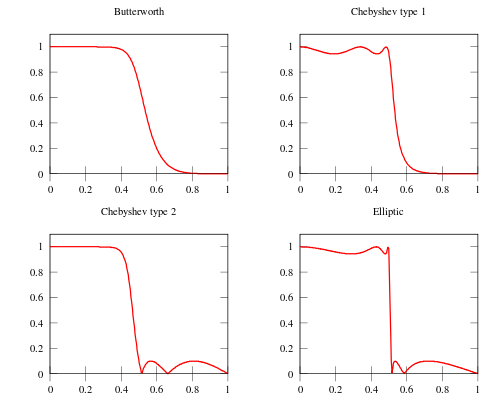巴特沃斯滤波器 (英語:Butterworth filter )是一种通频带 频率响应 曲线平坦無漣波的信号处理滤波器 最大平坦滤波器 。这种滤波器最先由英国 工程师 、物理学家 史蒂芬·巴特沃斯 在1930年发表的论文《滤波器放大器理论研究》中提出的。[1]
一阶巴特沃斯低通滤波器的波特图 巴特沃斯滤波器的特点是通频带 频率响应 曲线最大限度平坦,没有漣波 ,而在阻频带则逐渐下降为零。[2] 波特图 上,从某一边界角频率开始,振幅随着角频率的增加而线性减少至负无穷。
一阶巴特沃斯滤波器的衰减率为每倍频 6 dB,每十倍频20 dB(所有一阶低通滤波器具有相同的归一化频率响应)。 [來源請求]
一阶至五阶巴特沃斯低通滤波器增益图,截止频率
ω
0
=
1
{\displaystyle \omega _{0}=1}
n dB/decade,其中 n 为滤波器阶数。 n 阶巴特沃斯低通滤波器的增益
G
(
ω
)
{\displaystyle G(\omega )}
G
2
(
ω
)
=
|
H
(
j
ω
)
|
2
=
G
0
2
1
+
(
ω
ω
c
)
2
n
{\displaystyle G^{2}(\omega )=\left|H(j\omega )\right|^{2}={\frac ((G_{0))^{2)){1+\left({\frac {\omega }{\omega _{c))}\right)^{2n))))
其中,
n = 滤波器的阶数
ωc =截止频率 =功率下降为 -3分贝时的 频率
G
0
{\displaystyle G_{0))
可以看出随着 n 趋近于无穷,增益变为一个矩形函数,频率低于 ωc 的会以
G
0
{\displaystyle G_{0))
c 的就会被抑制。对于较小的 n 值,截止就会变得不十分尖锐。
我们希望能够(通过拉普拉斯变换 )确定传递函数 H(s) ,其中
s
=
σ
+
j
ω
{\displaystyle s=\sigma +j\omega }
|
H
(
s
)
|
2
=
H
(
s
)
H
(
s
)
¯
{\displaystyle \left|H(s)\right|^{2}=H(s){\overline {H(s)))}
s
=
j
ω
{\displaystyle s=j\omega }
H
(
−
j
ω
)
=
H
(
j
ω
)
¯
{\displaystyle H(-j\omega )={\overline {H(j\omega )))}
H
(
s
)
H
(
−
s
)
=
G
0
2
1
+
(
−
s
2
ω
c
2
)
n
,
{\displaystyle H(s)H(-s)={\frac ((G_{0))^{2)){1+\left({\frac {-s^{2)){\omega _{c}^{2))}\right)^{n))},}
则对于虚数输入
s
=
j
ω
{\displaystyle s=j\omega }
上述表达式的 n 个极点 等距离地分布在半径 为 ωc 的圆 上,并关于虚轴对称。为了具有稳定性,传递函数 H(s) 要选择只包含 s 负实半平面的极点。第 k 个极点为
−
s
k
2
ω
c
2
=
(
−
1
)
1
n
=
e
j
(
2
k
−
1
)
π
n
k
=
1
,
2
,
3
,
…
,
n
{\displaystyle -{\frac {s_{k}^{2)){\omega _{c}^{2))}=(-1)^{\frac {1}{n))=e^{\frac {j(2k-1)\pi }{n))\qquad k=1,2,3,\ldots ,n}
因此,
s
k
=
ω
c
e
j
(
2
k
+
n
−
1
)
π
2
n
k
=
1
,
2
,
3
,
…
,
n
.
{\displaystyle s_{k}=\omega _{c}e^{\frac {j(2k+n-1)\pi }{2n))\qquad k=1,2,3,\ldots ,n.}
n 阶巴特沃斯低通滤波器的振幅和频率关系可用如下的公式表示:
G
n
(
ω
)
=
|
H
n
(
j
ω
)
|
=
1
1
+
(
ω
/
ω
c
)
2
n
{\displaystyle G_{n}(\omega )=\left|H_{n}(j\omega )\right|={1 \over {\sqrt {1+(\omega /\omega _{\mathrm {c} })^{2n))))}
其中:
G 表示滤波器的放大率,H 表示 傳遞函數 ,j 是 虚数单位 ,n 表示滤波器的级数,ω 是信号的 角频率 ,以弧度/秒 为单位,
ω
c
{\displaystyle \omega _{\mathrm {c} ))
令截止频率
ω
c
=
1
{\displaystyle \omega _{\mathrm {c} }=1}
G
n
(
ω
)
=
|
H
n
(
j
ω
)
|
=
1
1
+
ω
2
n
{\displaystyle G_{n}(\omega )=\left|H_{n}(j\omega )\right|={1 \over {\sqrt {1+\omega ^{2n))))}
令 1/A=
G
n
(
ω
)
{\displaystyle G_{n}(\omega )}
n
=
l
o
g
10
(
A
2
−
1
)
2
l
o
g
10
(
ω
)
{\displaystyle n={\frac {log_{10}(A^{2}-1)}{2log_{10}(\omega )))}
例:在
(
ω
)
=
2
{\displaystyle (\omega )=2}
G
n
(
ω
)
{\displaystyle G_{n}(\omega )}
A= 200, n=7.6, 取大一号整数,即需要 8 阶巴特沃斯滤波器。
二阶巴特沃斯低通滤波器的波特图
g (2n-1) 次导数在ω = 0 时为零,说明放大率对 ω 是常数。
因此巴特沃斯滤波器又被称为最平坦的滤波器。
|
H
(
j
ω
)
|
2
d
B
=
40
n
l
o
g
10
ω
{\displaystyle ((\left|H(j\omega )\right|^{2))_{dB))={40n}{log_{10}{\omega ))}
因此,n 阶巴特沃斯低通滤波器的高频衰减为每十倍频20n 分贝。
k 阶巴特沃斯滤波器的考尔第一型电子线路图如下: 其中:
电容
C
k
=
2
s
i
n
[
(
2
k
−
1
)
2
n
π
]
{\displaystyle C_{k}=2sin\left[{\frac {(2k-1)}{2n))\pi \right]}
电感
L
k
=
2
s
i
n
[
(
2
k
−
1
)
2
n
π
]
{\displaystyle L_{k}=2sin\left[{\frac {(2k-1)}{2n))\pi \right]}
n
多项式因子
B
n
(
s
)
{\displaystyle B_{n}(s)}
1
(
s
+
1
)
{\displaystyle (s+1)}
2
s
2
+
1.414
s
+
1
{\displaystyle s^{2}+1.414s+1}
3
(
s
+
1
)
(
s
2
+
s
+
1
)
{\displaystyle (s+1)(s^{2}+s+1)}
4
(
s
2
+
0.7654
s
+
1
)
(
s
2
+
1.8478
s
+
1
)
{\displaystyle (s^{2}+0.7654s+1)(s^{2}+1.8478s+1)}
5
(
s
+
1
)
(
s
2
+
0.6180
s
+
1
)
(
s
2
+
1.6180
s
+
1
)
{\displaystyle (s+1)(s^{2}+0.6180s+1)(s^{2}+1.6180s+1)}
6
(
s
2
+
0.5176
s
+
1
)
(
s
2
+
1.414
s
+
1
)
(
s
2
+
1.9318
s
+
1
)
{\displaystyle (s^{2}+0.5176s+1)(s^{2}+1.414s+1)(s^{2}+1.9318s+1)}
7
(
s
+
1
)
(
s
2
+
0.4450
s
+
1
)
(
s
2
+
1.247
s
+
1
)
(
s
2
+
1.8022
s
+
1
)
{\displaystyle (s+1)(s^{2}+0.4450s+1)(s^{2}+1.247s+1)(s^{2}+1.8022s+1)}
8
(
s
2
+
0.3986
s
+
1
)
(
s
2
+
1.111
s
+
1
)
(
s
2
+
1.6630
s
+
1
)
(
s
2
+
1.9622
s
+
1
)
{\displaystyle (s^{2}+0.3986s+1)(s^{2}+1.111s+1)(s^{2}+1.6630s+1)(s^{2}+1.9622s+1)}
下图是巴特沃斯滤波器(左上)和同阶I型切比雪夫滤波器(右上)、II型切比雪夫滤波器(左下)、椭圆函数滤波器(右下)的频率响应图。
由图可见,巴特沃斯滤波器的衰减速度比其他类型滤波器缓慢,但十分平坦,没有幅度变化。
^ In Wireless Engineer (also called Experimental Wireless and the Wireless Engineer ), vol. 7, 1930, pp. 536–541 - "On the Theory of Filter Amplifiers"-S. Butterworth (页面存档备份 ,存于互联网档案馆 )
^
Giovanni Bianchi and Roberto Sorrentino. Electronic filter simulation & design . McGraw-Hill Professional. 2007: 17–20. ISBN 978-0-07-149467-0
Matthaei, George L.; Young, Leo and Jones, E. M. T., Microwave Filters, Impedance-Matching Networks, and Coupling Structures , McGraw-Hill, 1964 . 






















![{\displaystyle C_{k}=2sin\left[{\frac {(2k-1)}{2n))\pi \right]}](https://wikimedia.org/api/rest_v1/media/math/render/svg/50d89f2453b8a712f3162f798c07856760f0730d)
![{\displaystyle L_{k}=2sin\left[{\frac {(2k-1)}{2n))\pi \right]}](https://wikimedia.org/api/rest_v1/media/math/render/svg/7ffa00d054b88288f1eb485483ac4dc8867dde0a)









